NPSHA: NPSH determined by the purchaser for the pumping system with the liquid at the rated flow and normal pumping temperature. {API 610}
NPSH: (net positive suction head) Absolute inlet total head above the head equivalent to the vapor pressure referred to the NPSH datum plane. {API 610}
NOTE NPSH is expressed in metres (feet) of head of the pumped liquid. {API 610}
The easiest way to calculate NPSHA is as follows:
NPSHA (m) = (Psuction – Pv) x 100 / (9.81 x min .fluid relative density)
- Psuction = suction pressure (bar absolute) = Patm + Pstatic head – Ploss
- Please note that BAROMETER that is shown in data sheet, indicates atmosphere pressure.
- Pv = Vapor pressure (bar absolute)
Cavitation – the formation and subsequent collapse of vapor-filled cavities in a liquid. {Exxon Mobile}
To avoid cavitation, the NPSHA of the system must be greater than the NPSHR of the pump. NPSHA is calculated using the following equation: {Exxon Mobile}
NPSHA = hp – hvpa + hst – hfs – ha
where:
- hp – absolute pressure head in feet (meters) on the surface of the liquid supply level.
- hvpa – Vapor pressure of the liquid converted to feet (meters).
- hst – Static height in feet (meters) difference between liquid level and established pump datum.
It is positive if the liquid level is above the pump datum and negative if the liquid level is below the pump datum. The liquid level used should be the minimum operable liquid level for the vessel. The pump datum level is arbitrarily set 2 ft (0.6 m) above the grade datum level. See Section X-A, Suction Pressure and NPSH for more information.
- hfs – All suction line losses converted from pressure to feet (meters) including piping entrance losses and friction losses through the pipe, valves, fittings, permanent strainers where specified, etc.
- ha – Acceleration head for reciprocating pumps only. It accounts for head losses due to pulsation in the flow. See Section X-F NPSH Available-Acceleration Head for information on how to calculate this value. (ha = 0 for centrifugal and rotary pumps).
Pressure is converted to head in feet and meters using the following equations:

SAFETY FACTOR
When calculating NPSHA, a safety factor is used to further ensure cavitation free performance of the pump. The safety factor is defined as follows:

The following values are recommended for use in pumping service design:

*Consult machinery specialists to obtain experienced pump vendor NPSHR data.
A 5 psi pressure drop is used as a safety factor for boiler feed water pumps (refer to Section XXVI-B, Steam Generation Systems).
Choosing safety factors in excess of the table values are not recommended because doing so can add unnecessary cost to the pump selection and adversely affect pump hydraulic design.
25 FT (7.6 METERS) NPSHA CONVENTION
NPSH Available seldom exceeds 25 ft (7.6 meters) in practical economic design. Even when it does, the actual value seldom influences pump selection. As a convention, when the NPSH available is calculated to be higher than 25 ft (7.6 meters), a value of 25 ft (7.6 meters) “minimum” is specified, rather than the actual value. This simplifies the engineering process. Exception to this convention occurs when circumstances justify special engineering of the service NPSH aspects, such as when it is economically attractive to deliberately allow the NPSHA to be higher than 25 ft (7.6 meters), and when the optimum individual pump size can be expected to have an NPSHR over 25 ft (7.6 meters). In such a case, vendor data should be obtained to corroborate the NPSHR estimating data of Section X-A Pumping Service Design Procedures, and the actual NPSHA should be specified, along with information on available pump models.
EXAMPLES OF NPSHA CALCULATION
For the following examples, assume that the datum given is 2 ft (0.6 m) above the grade datum level per Section X-A Pumping Service Design Procedures, Suction Pressure and NPSH, Pump Datum Level.
EXAMPLE 1 – CALCULATION OF NPSHA FOR AN OPEN SYSTEM, SOURCE BELOW CENTRIFUGAL OR ROTARY PUMP

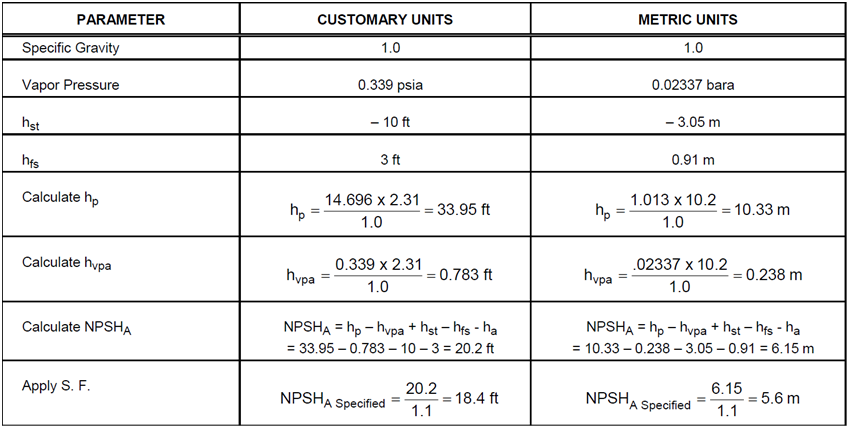
EX. 2 – CALCULATION OF MINIMUM REQUIRED VESSEL ELEVATION FOR AN OPEN SYSTEM, SOURCE ABOVE CENTRIFUGAL OR ROTARY PUMP

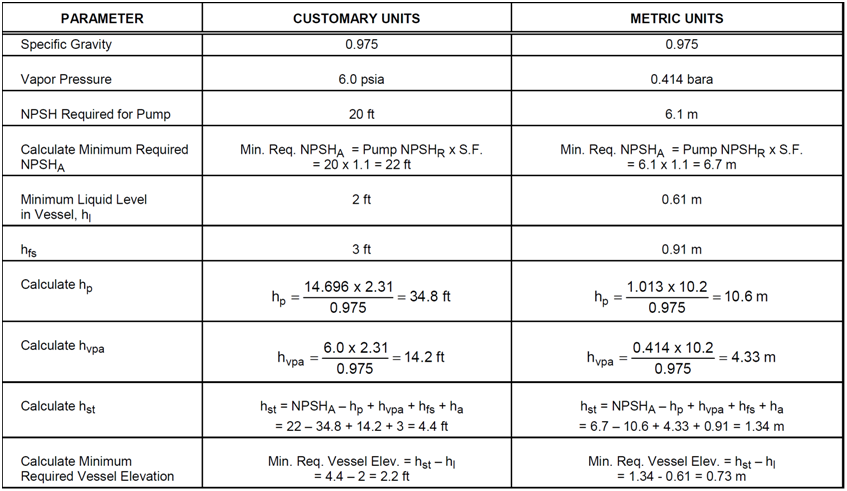
EX. 3 – NPSHA FOR A CLOSED SYSTEM, SOURCE ABOVE CENTRIFUGAL OR ROTARY PUMP
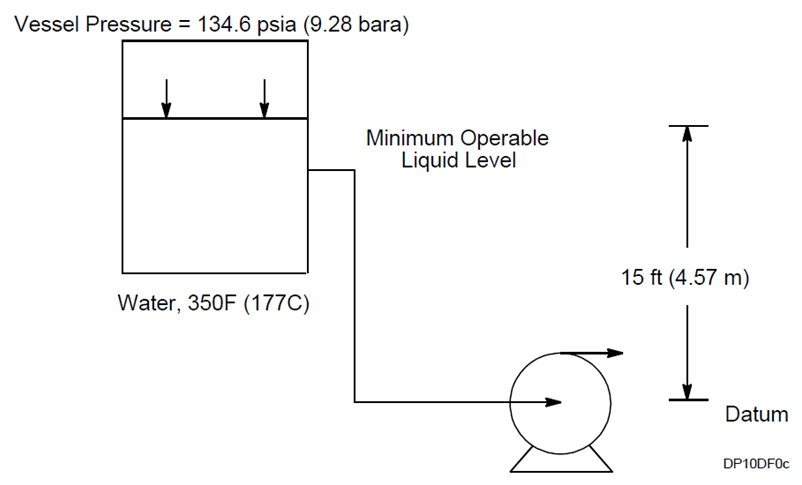
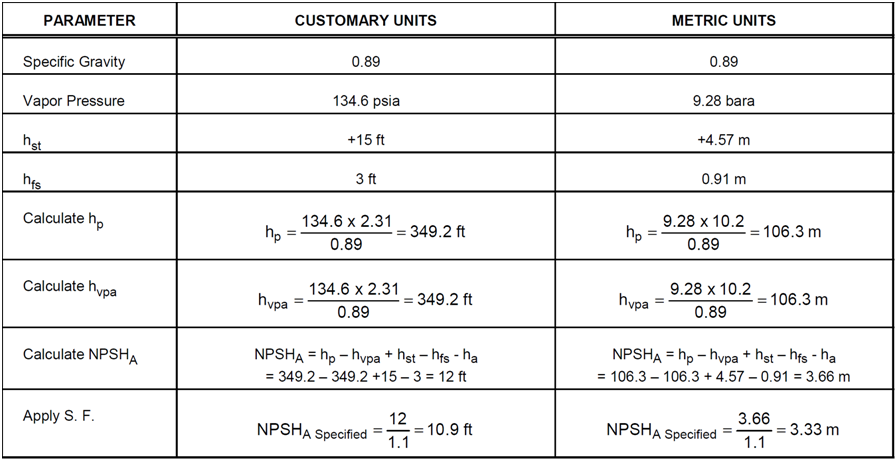
EX. 4 – CALCULATION OF MINIMUM REQUIRED VESSEL ELEVATION FOR AN OPEN SYSTEM, SOURCE ABOVE RECIPROCATING PUMP
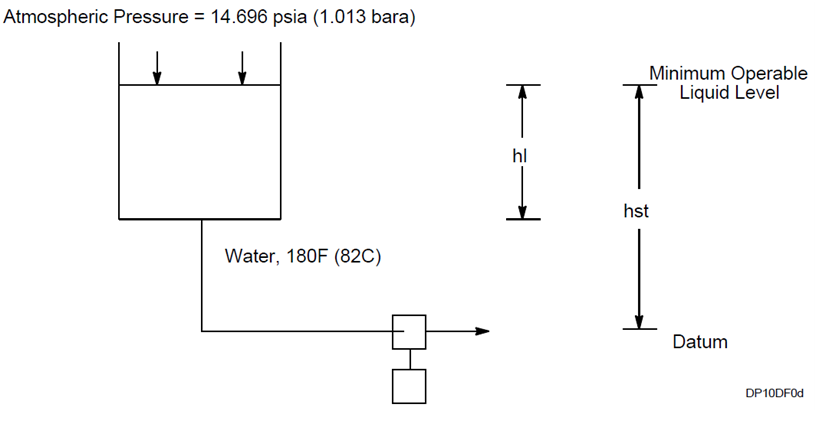

Comments:
